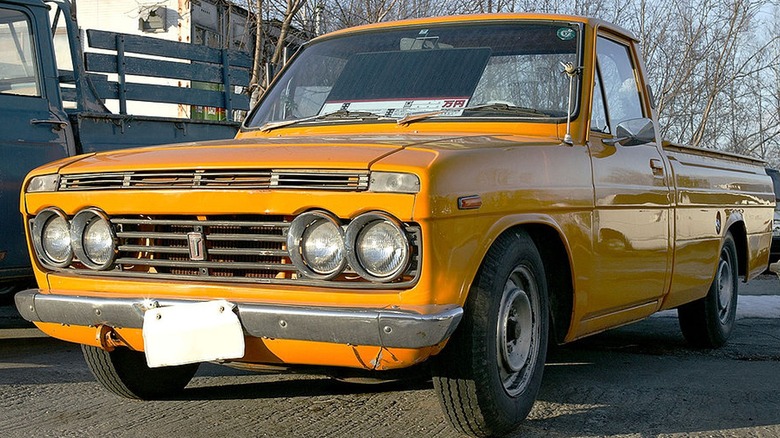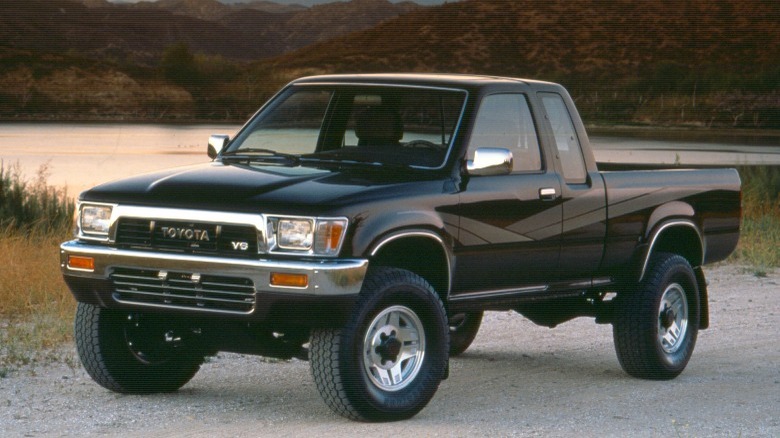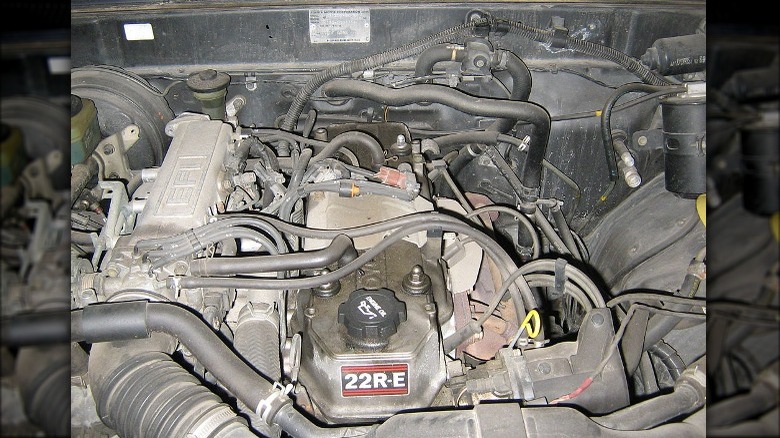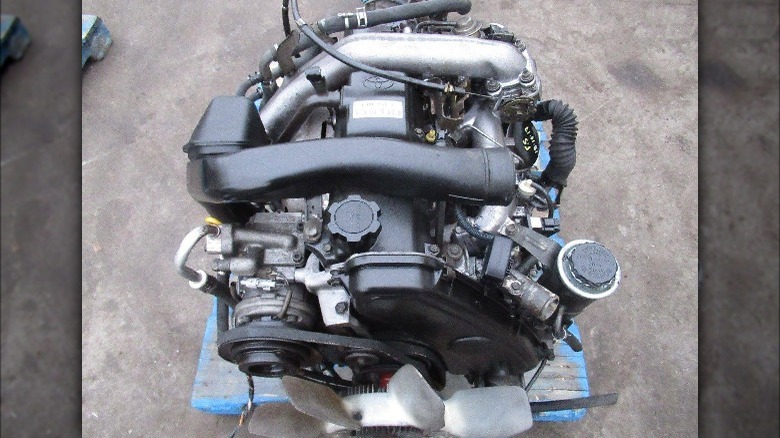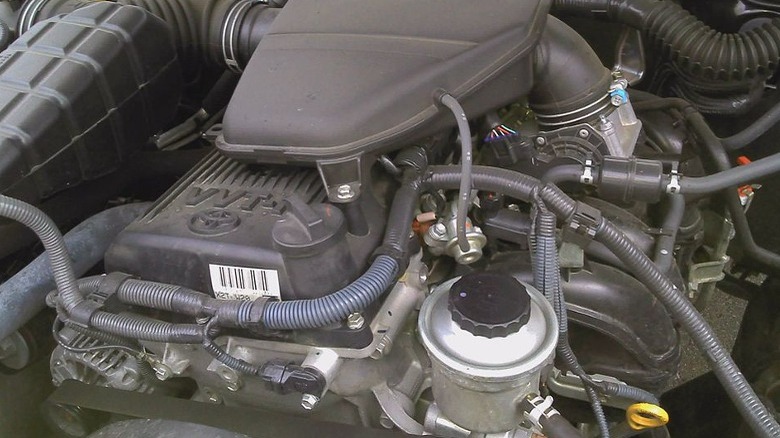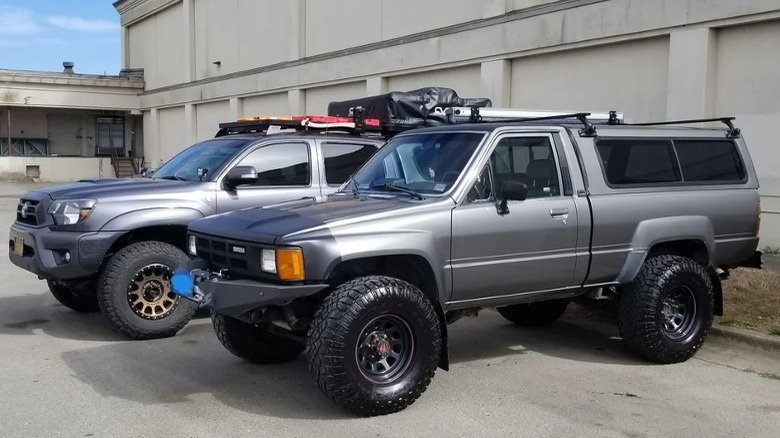5 Of The Best Toyota Engines Ever Put In The Hilux
The Toyota Hilux is one of its most impressive creations. The truck was designed as a bridge between the rugged platform demanded by industry types and a comfortable daily driver in which you'd be happy to cruise around town. No matter your job site requirements, haulage needs, or commute length, the Hilux stood ready to deliver a fantastic experience. Unfortunately for American drivers, new Hilux models stopped arriving on U.S. shores in the 1990s with the introduction of the Tacoma. Functionally, Hilux models aren't built in the United States and therefore are subject to regulations found under the Imported Vehicle Safety Compliance Act (IVSCA). This means a Hilux on American streets today is a vintage treat and an example of classic engineering design.
Under the hood of Toyota Hilux trucks, the company went all-in to provide drivers with a reliable engine and all the power they required. These trucks are brutish and relentless, with performance standards sure to excite any vintage truck enthusiast. But among the scores of engines that Toyota installed in the Hilux over the decades since its first production models in 1968, these are five of the best.
[Featured image by Tennen-Gas via Wikimedia Commons | Cropped and scaled | CC BY-SA 3.0]
The 3VZ-FE (found in the 1989 Hilux SR5)
In 1989, the Toyota Hilux was offered in a 4x4 SR5 build. This sturdy pickup truck was powered by a 2.4L Inline Four or an optional (and very much worth the upgrade) enlarged V6 engine, the 3VZ-FE. Hilux models of this era were sometimes known simply as the "Toyota Pickup," but the 3.0L V6 powerplant remained a staple of the truck's internal mechanisms. The engine produced as much as 185 horsepower and 189 lb-ft of torque. However, many outlets note a top output of 150 horsepower and 180 lb-ft of torque. The engine was built between 1987 and 1997 with a cast iron block and aluminum cylinder heads. It's a naturally aspirated four-stroke construction that utilizes a DOHC valvetrain.
Paired with a five-speed manual transmission (complete with overdrive), these Hilux trucks offered a phenomenally responsive and fun ride. The experience was bundled into a vehicle that remained supremely reliable over the course of many, many miles, as well. Estimates place the lifespan for these units at 180,000 miles, a serious contender for any driver considering a vastly durable daily driver.
2.4L 22R-E Straight Four (1983 to 1995)
The 22R-E was the original groundbreaker for Toyota. This powerplant is often referred to as the "one million mile engine," pointing directly to a measure of reliability and durability that's second to none. This engine was first introduced in 1982 and quickly became a staple in Toyota vehicles across the catalog. The Straight Four build was powerful and peppy, and this 2.4L addition under the hood replaced the smaller 2.0L 20R that had done the job beforehand. The engine is similar in function to the legendary HEMI engines produced by Chrysler, as well. The combustion chamber is hemispherical and induces a swirling effect much like the vaunted power producer from one of Toyota's major competitors.
The cast iron block and aluminum cylinder head construction add to an electronic fuel injection system to complete the mix. In terms of performance, the 22R-E engine produces as much as 109 horsepower and 140 lb-ft of torque. The longevity of the engine itself, combined with the long-running manufacturing of these powerplants, suggests a fundamentally sound building block for a fabulous vehicle.
[Featured image by dave_7 via Wikimedia Commons | Cropped and scaled | CC BY 2.0]
3.0L 1KZ-TE Turbo Diesel engines
In the early 2000s, Toyota added a Turbo Diesel engine that offered the power and performance that previous models had lacked when placed in Hilux frames. The 1KZ-TE first rolled off the production lines in 1993, offering some time to tweak the performance and design for this special truck (1997 for the Australian Mk.6 Hilux and 2003 for the 120-Series LandCruiser Prado, for instance). Unfortunately for American drivers, the 1KZ-TE Turbo Diesel remains just a few years too young for import but will come to maturity, so to speak, under IVSCA guidelines very shortly.
These engines are supremely reliable, as many diesel powerplants are. And with the turbocharged nature of the 1KZ-TE taken into consideration, the performance specifications of a Hilux powered by one of these beasts are also naturally elevated. The Straight Four engine produces up to 145 horsepower and up to 253.1 lb-ft of torque at a low 2,000 RPM range. They were built as a single, cast iron block with a balanced steel crankshaft.
2.7L 2TR-FE (VVT-i) Inline Four
Another more recent addition to the Toyota lineup, the 2TR-FE, was introduced in 2003. It replaced the 3RZ-FE powerplant and showcased a solid cast iron block construction. As a four-cylinder (Inline Four) power option, the engine provides a quality blend of power output and fuel efficiency that many drivers will search for in their vehicles. Moreover, the engine block utilizes counter-rotating balancing shafts to dampen noise and vibration for a more comfortable commute.
Estimates suggest that the 2TR-FE is rated for a lifespan of around 250,000 miles, making it a workhorse of an engine compared to many others that offer seemingly long-lasting durability. Similarly, the engine is still being produced by Toyota, speaking directly to its versatility and this mark of reliability. The engine produces a peak of 164 horsepower and 181 lb-ft of torque. It also uses Toyota's VVT-i system for the intake camshaft (Variable Valve Timing with intelligence). From 2015 onward, the engine utilizes a dual VVT-i setup, with this installation targeting both the intake and exhaust camshafts.
[Featured image by Yones via Wikimedia Commons | Cropped and scaled | CC BY-SA 3.0]
1986 and 1987's 4x4 Hilux with the Turbocharged 22R-TE
The 22R-TE (Turbocharged) found its way into just a handful of Hilux models. 1986 and 1987 were the only years the four-cylinder engine could be identified beneath the hood, further limiting the sweet spot that this powerplant occupies. The engine was then replaced when Toyota's newest V6 entered the picture. The engine was built with a cast iron block and was oriented as a Straight Four measuring 2.4L.
The engine produced 135 horsepower and 172 lb-ft of torque (at just 2,800 RPM). These engines are particularly enjoyable for drivers who love the classics when paired with a manual transmission — yet another feature that wasn't always delivered alongside the Hilux models adorned with the 22R-TE. The 4x4 build brought a lighter frame to bear, improving the responsive feel of this special engine even further. These Hilux builds' muscular, vintage 80s aesthetic is stripped down and offers drivers a true connection with the road. The engine plays a central role in providing this experience.
